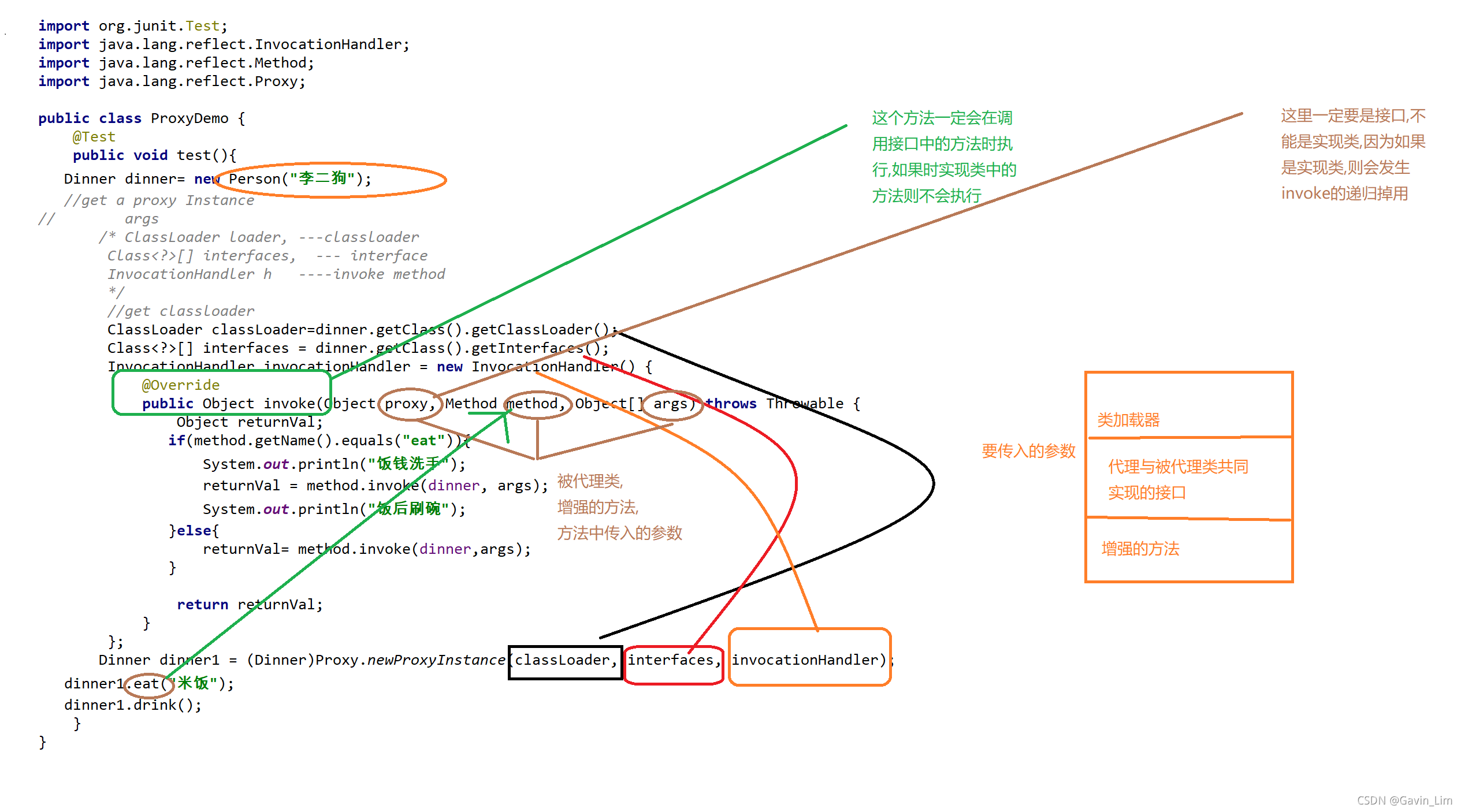早接触java设计模式时就了解过很多设计模式,记得我接触到的设计模式----->>>
单例模式
观察者设计模式
适配器模式
工厂设计模式
代理设计模式
本文主要写一些对于代理模式的理解
还是发一下以前写的代理模式
现在有一种情况.
例如:张扬属于老好人.也不差钱.马跃向张扬借了10000块.规定一年后还.一年之后.当张某再次向 马某讨债的时候.张某在无奈之下找到 范某.范某经营一家讨债公司.基本上手法:刀子。手枪
范某为了成功的把钱讨回来.准备好了笑道.绳索.钢筋.钢锯
马某害怕了.之后还钱
债讨回来了.范某要销毁罪证。
张某 -----范某------讨债
讨债工作由范某完成.但是真正的债主是张某.凡剖只是代理张某去完成讨债工作;所以在java中.我们将这种设计模式称为代理设计模式;
传统的纯java代码
interface Give {
public void giveMoney();}
class RealGive implements Give {
public void giveMoney() {
System.out.println("还钱"); }}
class ProxyGive implements Give { // 讨债公司
private Give give = null;
public ProxyGive(Give give) {
this.give = give; }
public void Before() {
System.out.println("准备工具"); }
public void giveMoney() {
this.Before();
this.give.giveMoney();// 代表真正讨债者完成讨债
this.After();
}
public void After() {
System.out.println("销毁罪证");
}}
public class Nullable {
public static void main(String args[]) {
Give give = new ProxyGive(new RealGive());
give.giveMoney();
}
}
与时俱进一下,spring,换一个流程,张三要去吃饭,
public interface Court {
void doCourt();
}
@Repository("people")
class People implements Court {
@Value("张三")
private String name;
public People() {
}
public People(String name) {
this.name = name;
}
public String getName() {
return name;
}
public void setName(String name) {
this.name = name;
}
@Override
public void doCourt() {
System.out.println(this.name + ":我是无罪的");
}
}
import org.springframework.beans.factory.annotation.Autowired;
import org.springframework.beans.factory.annotation.Qualifier;
import org.springframework.stereotype.Service;
@Service("law")
public class Law implements Court{
@Autowired
@Qualifier("people")
private People people;
@Override
public void doCourt() {
System.out.println("被告人"+people.getName()+"有不在场的证据");
people.doCourt();
}
}
import com.gavin.Proxy.Law;
import org.junit.Test;
import org.springframework.context.annotation.AnnotationConfigApplicationContext;
import org.springframework.context.annotation.ComponentScan;
@ComponentScan(basePackages = "com.gavin")
public class testone {
@Test
public void test(){
AnnotationConfigApplicationContext ac = new AnnotationConfigApplicationContext(testone.class);
Law law = ac.getBean("law", Law.class);
law.doCourt();
}
}
原理基本是一样的,代理方和被代理方都是实现同一个接口,通过代理对象访问目标对象,这样可以在目标对象基础上增强额外的功能,如添加权限,访问控制和审计等功能。
但是这种方式属于静态代理,这就说明我们的一个静态代理类只能代理一个类,并且还要事先知道我们要代理哪个类才能写代理类,如果我们有其他类还想使用代理那就必须再写一个代理类。然而在实际开发中我们是可能是有非常多的类是需要被代理的,并且事先我们可能并不知道我们要代理哪个类。所以如果继续使用静态代理反而会增加许多的工作量,并且效率低下,代码复用率也不好。
总结
1在不修改原有代码的 或者没有办法修改原有代码的情况下 增强对象功能 使用代理对象 代替原来的对象去完成功能
进而达到拓展功能的目的
2JDK Proxy 动态代理面向接口的动态代理 一定要有接口和实现类的存在 代理对象增强的是实现类 在实现接口的方法重写的方法
生成的代理对象只能转换成 接口的不能转换成 被代理类
代理对象只能增强接口中定义的方法 实现类中其他和接口无关的方法是无法增强的
代理对象只能读取到接口中方法上的注解 不能读取到实现类方法上的注解
JDK中的动态代理----PROXY
动态代理两种实现方式-----
实现接口的
继承父类的
本质都是去覆写一些方法来完成代理;
再JDK中通过proxy来实现面向接口的代理;
还有一个第三方的 clib来实现面向父类的代理
代码实现------>>
准备,接口一个
public interface Dinner {
void eat();
void drink();
}
准备两个实现类
public class Person implements Dinner{
private String name;
public Person() {
}
public Person(String name) {
this.name = name;
}
public void setName(String name) {
this.name = name;
}
@Override
public void eat(String foodName) {
System.out.println(name+"在吃"+foodName);
}
@Override
public void drink() {
System.out.println(name+"在喝啤酒");
}
}
public class Student implements Dinner{
private String name;
public Student() {
}
public Student(String name) {
this.name = name;
}
public void setName(String name) {
this.name = name;
}
@Override
public void eat(String foodName) {
System.out.println(name+"在吃"+foodName);
}
@Override
public void drink() {
System.out.println(name+"在喝雪碧");
}
}
准备动态代理的实现
首先要了解Proxy类的API,
不妨来一起看一下
继承实现关系
public class Proxy extends Object implements Serializable
类描述:
Proxy提供静态方法来创建像实例一样的对象 接口,但允许自定义方法调用。 为某个接口创建代理实例
构造方法---->
protected Proxy(InvocationHandler h)
构建一个新的 Proxy来自子类的实例 (通常是动态代理类)具有指定值 为其调用处理程序。
类中的方法---->>

下面就开始实践----->>
import org.junit.Test;
import java.lang.reflect.InvocationHandler;
import java.lang.reflect.Method;
import java.lang.reflect.Proxy;
public class ProxyDemo {
@Test
public void test(){
Dinner dinner= new Person("李二狗");
//get a proxy Instance
// args
/* ClassLoader loader, ---classloader
Class<?>[] interfaces, --- interface
InvocationHandler h ----invoke method
*/
//get classloader
ClassLoader classLoader=dinner.getClass().getClassLoader();
Class<?>[] interfaces = dinner.getClass().getInterfaces();
InvocationHandler invocationHandler = new InvocationHandler() {
@Override
public Object invoke(Object proxy, Method method, Object[] args) throws Throwable {
Object returnVal;
if(method.getName().equals("eat")){
System.out.println("饭钱洗手");
returnVal = method.invoke(dinner, args);
System.out.println("饭后刷碗");
}else{
returnVal= method.invoke(dinner,args);
}
return returnVal;
}
};
Dinner dinner1 = (Dinner)Proxy.newProxyInstance(classLoader, interfaces, invocationHandler);
dinner1.eat("米饭");
dinner1.drink();
}
}
代码解析----->>>
首先是两个是实现类,不做过多赘述,重点在于代理类

第三方CJLIB实现动态代理
在spring中引入了人第三方动态代理,所以直接导入spring核心包就可以了
cjlib是通过子类覆写父类方法来达到方法增强的目的;
举个例子

通过配置cjlib实现动态代理























 1093
1093











 被折叠的 条评论
为什么被折叠?
被折叠的 条评论
为什么被折叠?










